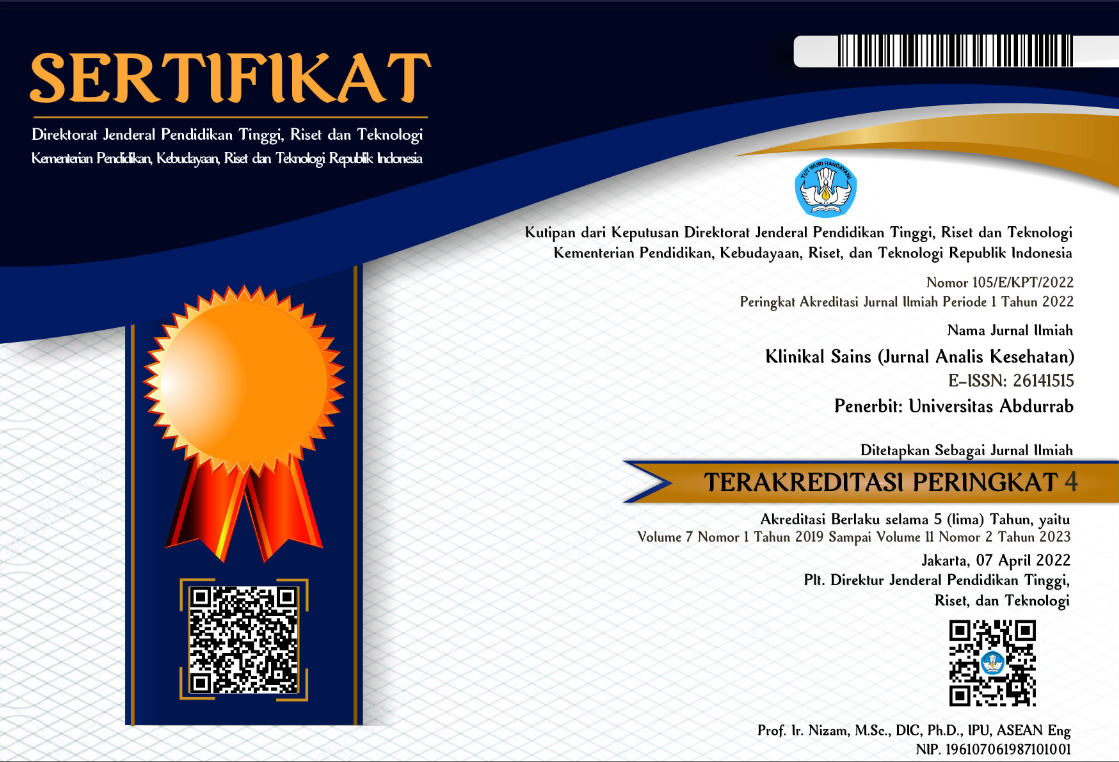PENGGUNAAN EKSTRAK KAYU SECANG DAN KOL UNGU PADA MEDIA MANITOL SALT AGAR UNTUK MENUMBUHKAN Staphylococcus
Abstract
Mannitol Salt Agar (MSA) is a selective and differential medium for isolating Stapylococcus bacteria, distinguishing Staphylococcus aureus bacteria from other species from the ability of mannitol to ferment which changes the color of the phenol red indicator from red to yellow. The use of synthetic indicators that are not environmentally friendly and difficult to decompose can be replaced with natural indicators, including the use of secang wood extract (Caesalpinia sappan L.) and purple cabbage (Brasicca oleraceae). The research was conducted using a descriptive method which describes the color changes of the modified mannitol salt agar (MSA) media of secang wood and purple cabbage extract after being planted with bacteria. Staphylococcus aureus and Coagulation Negative Staphylococcus (CoNS) bacteria were isolated from acne-prone skin. The growth of Staphylococus aureus changed the color of the modified MSA medium from red to yellow for the secang wood extract and the color change from blue to pink for the purple cabbage extract. The growth of CoNS bacteria changed the color of the modified MSA medium from red to red-orange for the secang wood extract and the color change from blue to blue-purple for the purple cabbage extract. Both bacteria thrived on purple cabbage modified MSA media. From this study, it was concluded that secang wood extract and purple cabbage could be used as natural indicators of modified MSA in growing Staphylococcus isolated from the skin.
References
Bier, K. dan Schittek, B. (2021) “Beneficial effects of coagulase-negative Staphylococci on Staphylococcus aureus skin colonization,” Experimental Dermatology, 30(10), hal. 1442–1452. doi:10.1111/exd.14381.
Drozdowska, M. et al. (2020) “Young shoots of red cabbage are a better source of selected nutrients and glucosinolates in comparison to the vegetable at full maturity,” European Food Research and Technology, 246(12), hal. 2505–2515. doi:10.1007/s00217-020-03593-x.
Fatoni, A. et al. (2019) “Natural reagent from Secang (Caesalpinia sappan L.) heartwood for urea biosensor,” IOP Conference Series: Materials Science and Engineering, 509(1), hal. 0–7. doi:10.1088/1757-899X/509/1/012010.
Foster, T.J. dan Geoghegan, J.A. (2014) “Staphylococcus aureus,” in Molecular Medical Microbiology. Elsevier Ltd, hal. 655–674. doi:10.1016/B978-0-12-397169-2.00037-8.
Ghareaghajlou, N., Hallaj-Nezhadi, S. dan Ghasempour, Z. (2021) “Red cabbage anthocyanins: Stability, extraction, biological activities and applications in food systems,” Food Chemistry, 365(March), hal. 130482. doi:10.1016/j.foodchem.2021.130482.
Jenkins, C.L. dan Bean, H.D. (2020) “Influence of media on the differentiation of Staphylococcus spp. By volatile compounds,” Journal of Breath Research, 14(1). doi:10.1088/1752-7163/ab3e9d.
Leboffe, M.J. dan Pierce, B.E. (2012) Microbiology: Laboratory Theory & Application, Brief, Second Edition Second Edition.
Leelakhachonchit, P. et al. (2021) “The Effects of Heartwood Extracts from Biancaea sappan L . against Coagulase-Negative Staphylococci ( CoNS ) and Staphylococcus aureus Isolated from Subclinical Mastitis in Dairy Goats,” 14(Mic), hal. 31–46.
Ngamwonglumlert, L. et al. (2020) “Color and molecular structure alterations of brazilein extracted from Caesalpinia sappan L. under different pH and heating conditions,” Scientific Reports, 10(1), hal. 1–11. doi:10.1038/s41598-020-69189-3.
Nguyen, T. et al. (2019) “Targeting mannitol metabolism as an alternative antimicrobial strategy based on the structure-function study of mannitol-1-phosphate dehydrogenase in Staphylococcus aureus,” mBio, 10(4), hal. 1–23. doi:10.1128/mBio.02660-18.
Oh, J. et al. (2016) “Temporal Stability of the Human Skin Microbiome,” Cell, 165(4), hal. 854–866. doi:10.1016/J.CELL.2016.04.008.
Phumudzo, T. et al. (2013) “Bacterial species identification getting easier,” African Journal of Biotechnology, 12(41), hal. 5975–5982. doi:10.5897/ajb2013.12057.
Susanti, R.E.E. et al. (2019) “Pemanfaatan Ekstrak Kubis Ungu (Brassica Oleraceae) Sebagai Indikator Warna Pada Analisis Hidrokuinon,” Akta Kimia Indonesia, 4(2), hal. 95. doi:10.12962/j25493736.v4i2.5134.
Ulma, Z., Rahayuningsih, E. dan Wahyuningsih, T.D. (2018) “Methylation of Brazilein on Secang (Caesalpinia sappan Linn) Wood Extract for Maintain Color Stability to the Changes of pH,” IOP Conference Series: Materials Science and Engineering, 299(1), hal. 0–7. doi:10.1088/1757-899X/299/1/012075.
Virgianti, D.P., Suhartati, R. dan Khusnul (2020) “Clitoria ternatea Linn Extract as Natural pH Indicator in Mannitol Salt Agar Medium,” 26, hal. 326–328. doi:10.2991/ahsr.k.200523.078.
Zhang, N. dan Jing, P. (2020) “Anthocyanins in Brassicaceae: composition, stability, bioavailability, and potential health benefits,” Critical Reviews in Food Science and Nutrition, 62(8), hal. 2205–2220. doi:10.1080/10408398.2020.1852170.
Copyright (c) 2022 Klinikal Sains : Jurnal Analis Kesehatan

This work is licensed under a Creative Commons Attribution-NonCommercial-ShareAlike 4.0 International License.
1. Copyright of all journal manuscripts is held by the Klinikal Sains : Jurnal Analis Kesehatan
2. Formal legal provisions to access digital articles of electronic journal are subject to the provision of the Creative Commons Attribution-ShareAlike license (CC BY-NC-SA), which means that Klinikal Sains : Jurnal Analis Kesehatan is rightful to keep, transfer media/format, manage in the form of databases, maintain, and publish articles.
3. Published manuscripts both printed and electronic are open access for educational, research, and library purposes. Additionally, the editorial board is not responsible for any violations of copyright law.
licensed under a Creative Commons Attribution-ShareAlike 4.0 International License.
 pdf
pdf
 Abstract views: 690
Abstract views: 690
 downloads: 1773
downloads: 1773

 :
:






